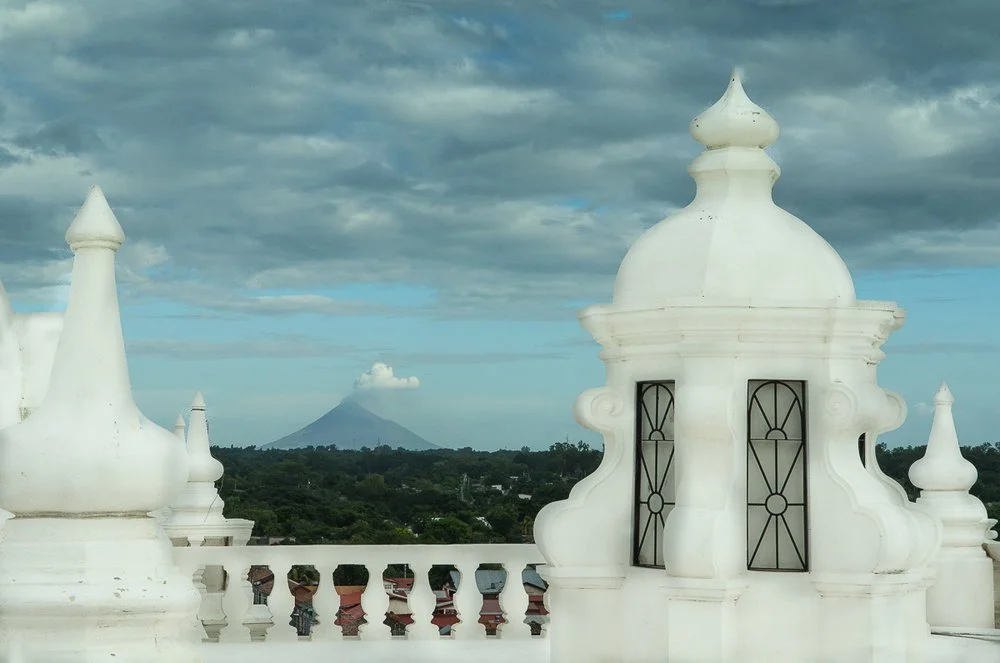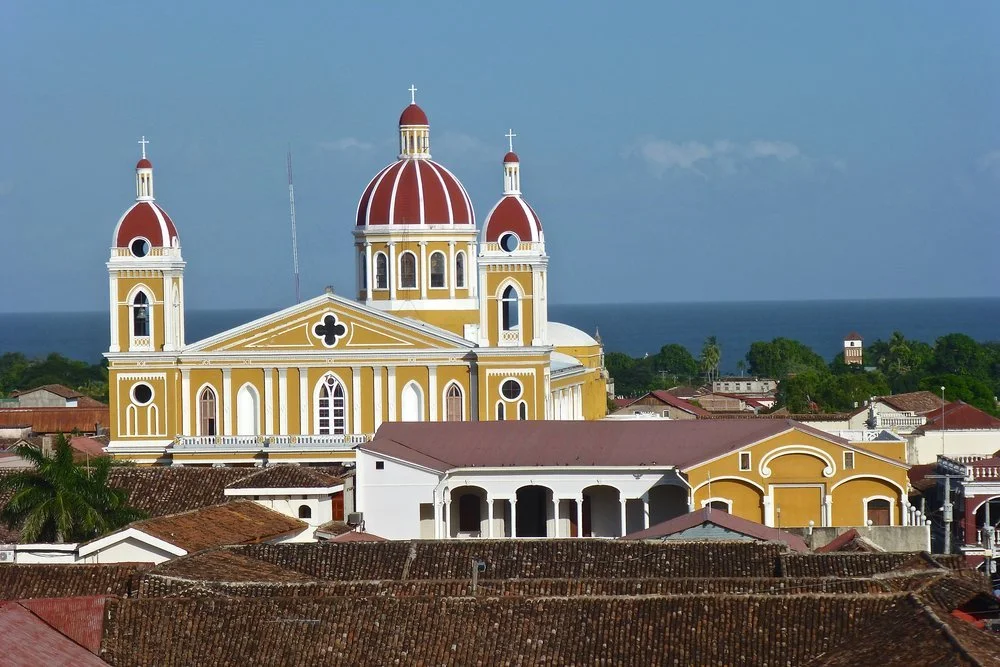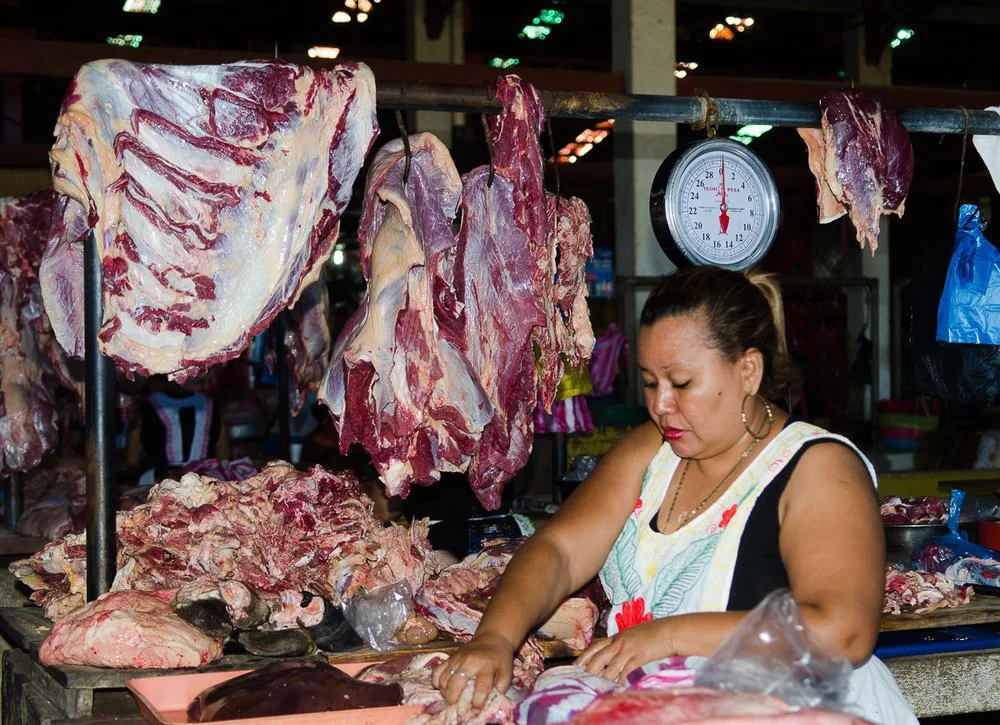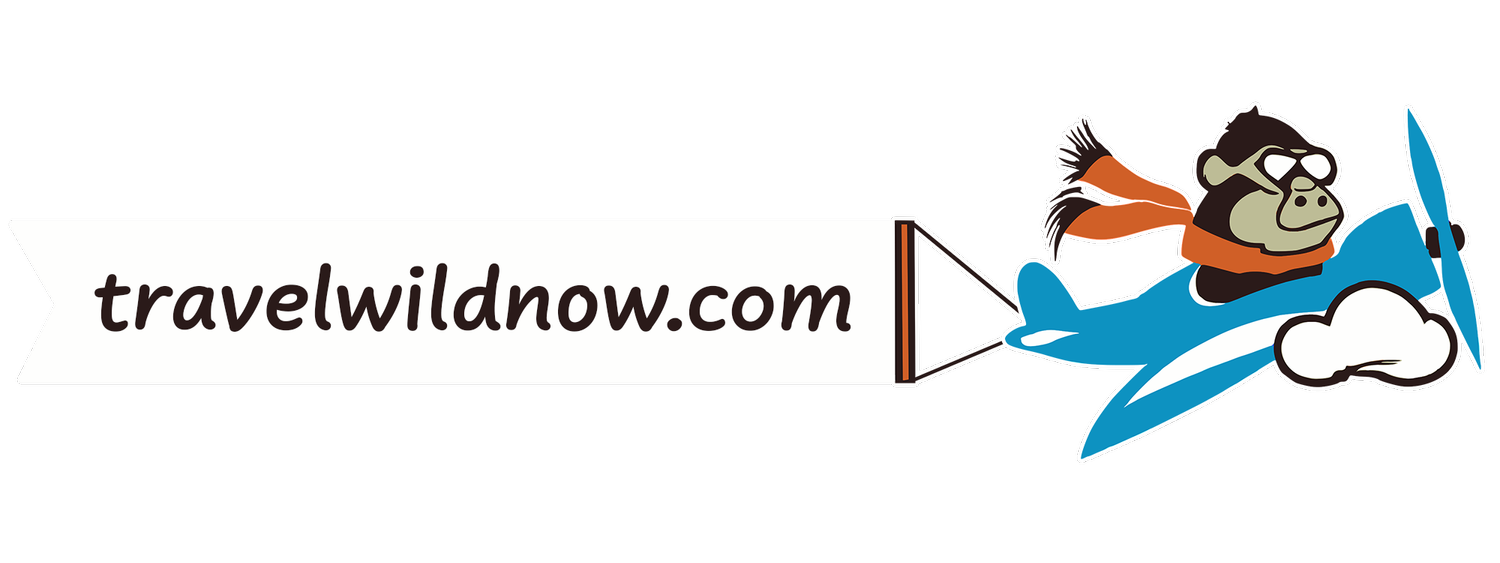
NICARAGUA 8 Days
This itinerary visits sophisticated Leon, the volcanoes, the colonial town of Granada, Mombacho Natural Reserve, a coffee plantation and Ometepe Island.
Nicaragua is a Central American country between the Pacific Ocean and the Caribbean Sea. It has a dramatic landscape with lakes, volcanoes, and beaches. North of the capital, Managua, are Lake Managua and the famous Momotombo volcano. South of the capital is Granada, known for its Spanish colonial buildings and nearby islands full of tropical birds.
Tips:
The weather in Nicaragua is very hot and humid year-round. Always keep hydrated and use sunscreen.
Tour Operators are recommended. They will manage the various components of your excursion. The cost of a personal tour guide is not overly expensive and well worth not dealing with hassles and unexpected problems.
Travel Guide: Lonely Planet Nicaragua.
DAY 1
Arrive at Managua airport and transfer to your hotel in Leon - a colonial town.
If time permits, explore Leon.
Leon is full of magnificent churches, colorful streets, delicious restaurants, vibrant student life and an active nightlife.
Overnight: Leon (3 nights)
Distance:
Airport --->Leon, 90 minutes / 100 km.
Cerro Negro Ash Boarding. Tour packages available with Nicaragua Adventures.
DAY 2
Highlights in Leon:
Leon, is the 2nd largest city in Nicaragua. It has long been the political and intellectual center of the nation.
Cathedral of the Assumption of Mary - the largest cathedral in Central America. The cathedral has been around since 1747. For a small fee, you can gain access to the roof and revel in the best views Leon has to offer–volcanoes included.
Visit the local market. Colorful stands offer local products.
Continue to Cerro Negro - a must do!
Experience Ash Boarding down the cinder cone volcano. Rent a board and take the 1 hour hike to the top for a thrilling experience! Plus the views at the top are fantastic.
The volcano is located in a rural area, 25 km northeast of León. The unpaved roads that lead to the volcano should be traveled in a high-clearance vehicle. Hiring a guide is highly recommended.
GPS coordinate:12.5078° N, 86.7022° W
Afterward return to Leon and explore the town center.
Overnight: Leon
Distance: Leon ---> Cerro Negro, 1 hr.
DAY 3
Today experience a true Volcano hike.
We recommend Telica Volcano, <Updates>
GPS coordinate: 12.6058° N, 86.8422° W
However if closed, Volcan del Hoya is a excellent alternative.
GPS coordinate:12.4894° N, 86.6675° W
Both hikes are about 5 hrs. round-trip.
Nicaragua has about 40 volcanoes, a half dozen of which are usually active at any time.
We strongly recommend a local guide when hiking any volcano. They are very knowledgable.
Overnight: Leon
Distance:
Leon ---> Telica or Volcan del Hoya, 1 hr.
DAY 4
Depart Leon. Your first stop is Catarina, a small village overlooking the Laguna de Apoyo Lagoon.
Apoyo is a stunning crater lake with a Mediterranean blue water. Hike down to the lagoon and enjoy the flora and fauna. Keep your eyes out for monkeys.
In the afternoon arrive in Granada, and stroll this charming city. Visit the town square and the old market.
Granada is one of the more elegant cities in Central America. With a sizable population of over 100,000 and a large expat community, the city is famous for its classic colonial architecture and postcard cathedrals and is home to an array of appealing museums, galleries, markets and more.
The colorful Calle Calzada neighborhood is the most tourist street in Granada. Bars, art galleries, craft shops and restaurants are abundant here.
Don’t miss the Iglesia La Merced. You can climb the stairs up to the tower and get great views of the city.
Overnight: Granada (2 nights)
Distance:
Leon ---> Apoyo Lagoon, 3 hrs.
Apoyo Lagoon ---> Grenada, 1 hr.
DAY 5
Continue to discover Granada.
Options include renting a bike to tour the town, and kayaking on Lake Nicaragua with tour guide.
Book a tour through your hotel front desk for Masaya National Park - an active volcano. Best time to visit the impressive Santiago Crater is with a late afternoon tour, right before sunset so you can capture the orange glow. <Learn more>
Caution: No more than 10-15 minutes is allowed at the crater viewpoint, because of the gases emanating from the crater poising a health risk.
Overnight: Granada
DAY 6
Depart Granada.
Mombacho Nature Reserve - a cloud forest with a rich ecosystem, Howler Monkeys and excellent views from the top.
We suggest a walk on the Crater trail or the more challenging Puma trail.
If time permits, tour a coffee plantation. Nicaragua produces excellent coffee. Cafe Las Flores is our preferred choice.
Afterward drive to San Jorge, where you will embark on a ferry (schedule) to Ometepe Island, the world's largest volcanic island in a lake. On route marvel at the impressive Volcan Concepcion. The Concepción is Nicaragua's second highest volcano and one of the most perfectly shaped volcanos of the Americas.
Overnight: Ometepe Island
Our favorites are Villa Paraiso and Totoco Ecolodge.
Distance:
Granada---> San Jorge, 1.5 hr.
San Jorge ---> Ometepe Island, 1 hr.- ferry ride
DAY 7
Ometepe Island highlights:
Ometepe Island is a lush tropical island formed from two (2) towering volcanoes, Volcano Concepción and Volcano Maderas. It offers tropical forests, waterfalls, hiking, swimming and kayaking.
Start the day hiking to the Maderas Volcano - San Ramon waterfall - a 90 minute walk. During the walk you may encounter colorful birds and whooping howler monkeys.
Getting there: The waterfall is accessed on a dirt road (through private property) that you can find on Google Maps. From the front gate (where you pay) you walk about 1.5 hours one way OR your tour operator has permission to drive further up the road.
In mid-afternoon take the ferry back to the mainland from Ometepe and transfer to your hotel in Managua before your flight home the next day.
Overnight: Managua
Suggested hotels close to airport.
Distance:
Ometepe Island ---> San Jorge Ferry Landing, 1 hr.
San Jorge ---> Managua, 2 hrs.
DAY 8
Depart for your flight home.
-
1. Are there many visitors coming to Nicaragua ?
Nicaragua is truly a Budget Paradise, especially when compared to Costa Rica and Panama. Since 2000, tourism has grown by 394% or 15-20% annually. It is often referred to as “The Next Costa Rica” by people traveling throughout the region.
2. Do I need power adapters?
Nicaragua has the SAME 110v power system as North America, so an adapter/ converter is not necessary.
3. Is the Food and Water Safe? What about buying coffee for home?
One of the best parts of Nicaragua is the year round availability of amazing fresh fruits and vegetables. Every town has one, or several, open air markets where you can purchase in season produce at an affordable price. One thing they don’t have in these markets is refrigeration, so this needs to be taken into account before you go shopping. We drink bottled water.
Coffee! This country has the ability of growing some amazing coffee as well. Excellent coffee product grown here.
4. What about health insurance and medicine ?
We recommend travel insurance in the rare case of an emergency. In Nicaragua, there are pharmacies in every town, sometimes on every corner. You can also get antibiotics without a Doctor’s visit. Sometimes tourists just tell the Pharmacist what their symptoms are and the Pharmacist sells them exactly what they need.
5. What are the Entry Requirements for Nicaragua?
A valid passport is mandatory to enter Nicaragua. Depending on your country of origin you may enter Nicaragua WITHOUT a visa for a maximum amount of up to 90 days. Its recommended you have at least six (6) months of validity from the date you return to your home country,
6. Where can I exchange money?
Nicaragua’s official currency is the Cordoba, however, US dollars are accepted throughout the country, especially in the main tourist areas. We recommend using US Dollars. <ATMs are the easiest way to get local currency. >
7. Is it easy to get sunburn, or get dehydrated in Nicaragua?
Nicaragua lies close to the equator, and as such, it’s VERY easy to get sunburnt or dehydrated. Never underestimate the tropical sun, even when it’s cloudy, and always protect yourself.
8. Are there many mosquitoes in Nicaragua?
Mosquitoes are common year-round in Nicaragua, and are most common at dusk and dawn. It’s a good idea to wear long-sleeved shirts and long pants during these times.
Average cost:
(EXCLUDING AIRFARE)
$$$ USD per person
Budget: $1,500
Moderate: $2,200
Luxury: $3,000 +
Climate
On average, the temperatures and humidity are always high.
Nicaragua has dry periods in December through April.
The best months to visit are December and January.
Nicaragua rainfall heaviest May through October (rainy season), best to avoid.
🌤️ Nicaragua Gallery
🎬 Video






































Source: roam nicaragua, wikipedi.orgNo copyright infringement is intended on this website by travelwildnow.com









